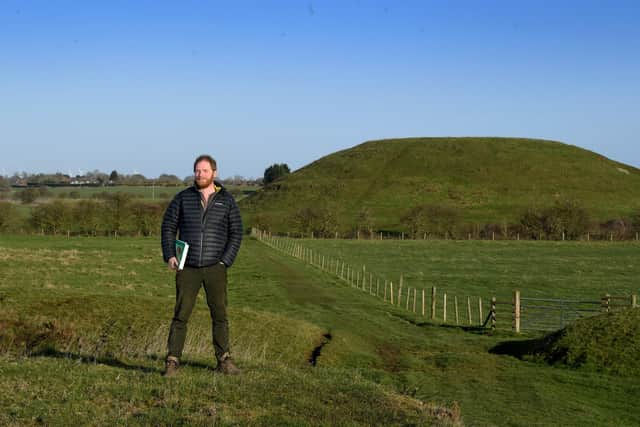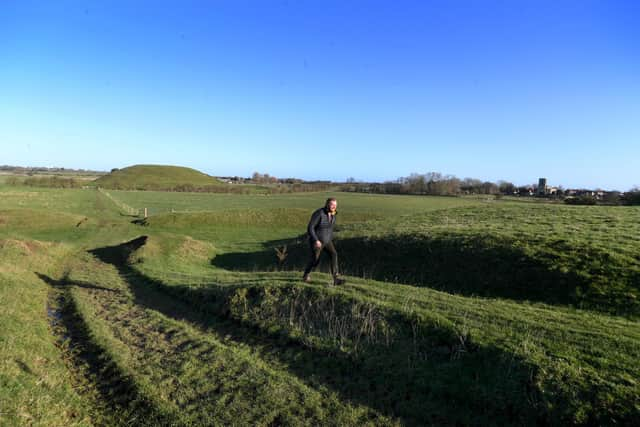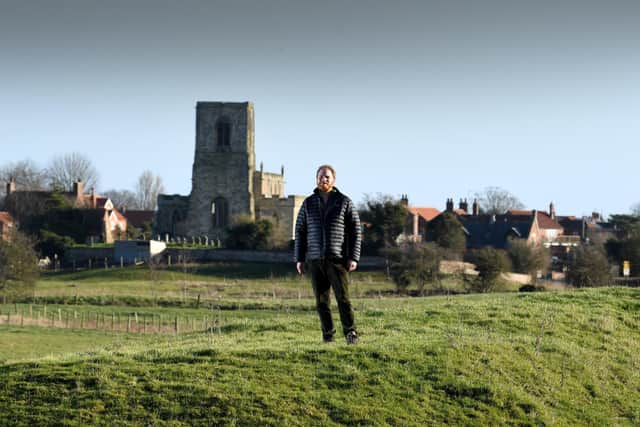Archaeologists prepare for new dig to probe Iron Age origins of mound under Skipsea Castle in Yorkshire
But this should change over the next six years as a team start to uncover a "completely overlooked" site rich in archeology from across the millennia - including potentially a unique Iron Age burial mound.
If Dr Jim Leary's theory is correct, it will be a first in the UK, and have more in common with the "princely" tombs found on the Continent, in Austria, Switzerland and Germany, which contain burial chambers and precious grave goods.
Advertisement
Hide AdAdvertisement
Hide AdDr Leary, from the University of York came across Skipsea's mound while investigating castle mottes across the country to find out whether they had prehistoric origins.


While nearly all turned out to be Norman, core samples drilled from the top to the base of Skipsea's mound revealed charcoal, which was radiocarbon dated to the Iron Age, 1,500 years earlier.
It may be that Drogo de la Beauvriére, a knight awarded a swathe of Holderness after fighting alongside William the Conqueror at the Battle of Hastings in 1066, chose to build his castle on top of the Iron Age mound, itself on a natural hillock.
The castle was destroyed in the early 13th century and the lake or mere which surrounded it was drained in the early 18th century, but the area can still get very wet in the winter.
Advertisement
Hide AdAdvertisement
Hide AdFinding evidence to confirm whether it is Iron Age is a key aim of field studies, starting this Spring, involving 100 undergraduates and experts including Elaine Jamieson, specialist in landscape archaeology and Professor Nicky Milner, whose research focuses on the Mesolithic.


Dr Leary said: "Not everyone agrees that the mound was constructed in the Iron Age, rather a medieval mound built over earlier Iron Age activity. My answer to that is - yes that could be true, we don't yet know. But If this was a blank canvas, it wouldn't be a choice spot for the Normans to come and build a castle. They have different drivers. In the Iron Age it's not about defensiveness, it's about sanctity, the sacred ritual.
"Wetlands weren't quite land or water, they were somewhere in-between, liminal zones. It is where we mostly find depositions, from the Bronze to the Iron and into the Roman Age."
With nothing else like it in the UK, they are looking towards the Continent, which Dr Leary says, is not surprising given East Yorkshire's focus in the Iron Age towards the Continent. They are seeking permission from Historic England to put a trench in on top of the ancient scheduled monument.
Advertisement
Hide AdAdvertisement
Hide Ad"We are very keen that we are excavating not only to satisfy our own thirst for knowledge, but for the public good and to make sure we are involving the community and making sure the information filters through to school children," he said.


The team will also be looking at the wider landscape where previously there have been finds dating back to the Mesolithic 12,000 years ago when hunter gatherers roamed the area.
The Skipsea drain, which wends its way through the site, was being redug in the 1880s when landowner Sir Thomas Boynton, who was overseeing the works, discovered timbers thought to belong to prehistoric "lake dwellings" - which he wrote about in The Yorkshire Post in 1883. At one of the sites, Round Hill, many multi-period finds were found including a human skull, pottery as well as fine objects including an amber bead and section of jet bracelet, largely of Neolithic and Bronze Age date.
Excavations in the early 90s found timber samples which were dated to the Mesolithic. Archaeologist Robert van de Noort suggested it was a lake-edge platform rather than a dwelling. But Dr Leary said: "I think we are looking at lakeside settlements. I am absolutely convinced.
Advertisement
Hide AdAdvertisement
Hide Ad"Boynton found shale bracelets, beads, polished axes, that indicates a pretty well off settlement in the pre-historic period. It could be Neolithic - it's more likely Bronze Age, like Must Farm in the Fens."
A third area they hope to put a trench in is in an area near the entrance to the site, making up part of the medieval village of Skipsea Brough, within the gigantic outer bailey of the Norman castle.
Dr Leary believes this landscape is "every bit as important as Avebury".
"By the end I think we will have a completely different understanding of this landscape," he said.
